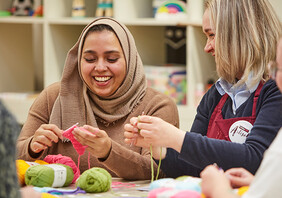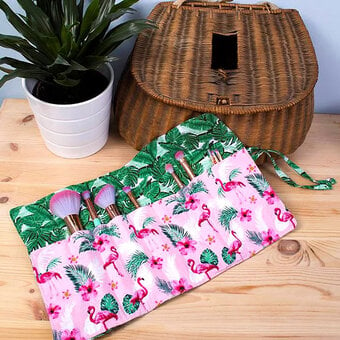How to Sew an Envelope Clutch Bag
Discover the new Enchanted Wings fabric collection by Hobbycraft Artisan Beth Salt. This step-by-step guide will show beginner sewers how to transform beautiful fabric from the collection into a stylish envelope clutch bag that's sure to make an impact at any event.
From beetles and butterflies to beautiful florals, the Enchanted Wings collection is a must-have for your fabric stash!
Project and instructions by Hobbycraft Artisan Beth Salt.
You will need
You will also need:
* Matching thread for your fabric
* An iron
Press your fabric by ironing on the wrong side to remove any creases to ensure your fabric is ready for cutting to size.
Once ironed, measure and cut out an outer fabric and inner lining into 54cm x 29.5cm panels.


Next, place the two pieces of fabric together and fold in half down the long edge to find the centre point, carefully mark the wrong side of one of the fabrics at the midpoint on the edge of the fabric.

Unfold the two pieces of fabric, keeping them one on top of the other with the marked side facing up. Using a ruler, measure up the long sides from the bottom edge of the fabric to 10cm, from each side measure diagonally from the midpoint to create a triangular shape.

Slowly cut along each diagonal line, through both the outer and inner fabric to create a triangular shape at one end of the fabric panels.


Next, take the Bosal in-r Form interfacing and using one of the fabric panels as a template, draw around this to create a matching shape out of the interfacing but with a length of 52.5cm instead of the 54cm of the fabric panels. This is because when the bag is turned out at a later stage, this short edge of the interfacing will not be sewn in with the rest of the fabric as it will become too bulky and will not allow for a neat finish if included.
Then, iron the lining fabric panel to the Bosal interfacing, one side has a rougher feel to the other, this is the side that will bond to the lining fabric. Carefully iron them together, do not hold the iron on each area for too long as it can begin to melt the interfacing and change the shape of your panels. Ensure the edges are all the lined up accurately, this will help when sewing the bag together as you will not miss any edges.



Place the outer fabric panel on top of the lining, right sides together. You can pin this together if you wish to, if you feel confident holding it together whilst you sew you can do this too but be mindful of the fabric shifting under the machine as you sew.

Sew carefully around the long edges and the triangular end with a short straight stitch about 0.5cm in from the edge. It is important this is done neatly as it will form the edges of the clutch bag when turned out. Ensure you do a reverse stitch and a forward stitch at the start and end of your stitching to ensure it does not pull apart. Then sew a short zig zag stitch around the same edges to ensure the fabric does not fray. Be careful not to go over the straight stitching.

Sew a rounded edge on the point of the triangle to give a softer look, if you would like to use a template, take a 2p coin and draw around this before sewing to ensure each side is equal. Cut the excess point off.
Along the short edge where the Bosal interfacing is shorter, sew through the two pieces of fabric to 10cm in from each side, sew to the edge of the Bosal but not through it. The gap left open is so that the bag can be turned out. Ensure you do a reverse stitch and a forward stitch at the start and end of your stitching to ensure it does not pull apart.
Gently turn the bag out by pulling the triangle end through the open end of the bag from the inside. Push out all the edges and corners and then gently iron both sides to create a neat panel.

Next, take the short open edge and top stitch along it, with a medium length stitch, outer fabric facing up. Neatly tuck the open fabric inside to create a straight edge and sew along it with the straight stitch. When cutting the thread, leave about 15cm free so that the thread can be handsewn later.
Then, carefully top stitch with a medium length stitch along the triangular end, remembering to leave a 15cm thread allowance for finishing of the stitching by hand at the end.

Next, with the iron to hand, fold over the triangular end, fold at 2cm down the edge so that the fold is not right on the line where the triangular sides begin, this helps the bag look neater as it will fold more sharply and keep the lining on the inside. Carefully iron this fold to create a sharper, neat edge and form the start of the clutch bag.
Then, take the other end of the fabric panel and fold this up to the first ironed fold, forming the envelope clutch, iron the second fold to help keep the shape for sewing.

Carefully sew down the short sides of the doubled fabric panel to create the bag shape. This will be thicker fabric so slow and steady sewing is best. Leaving a 15cm thread allowance the same as in the other steps to allow for the sewing to be neatly finished in a later step.

Using a hand sewing needle, carefully finish off all the stitching, sew all the threads that show on the outer sides of the bag inwards so that there are no exposed threads, carefully knot the threads together to secure the stitching. Then sew the threads back into the fabric to keep the knot secure and cut off the excess thread as close as you can to the fabric. Repeat this on any excess threads and stitching.

Hand stitch one side of the press stud onto the inside lining of the opening of the bag, in the middle of the rounded off triangle. Sew neatly all the way around the press stud to secure it to the bag, do not go through to the other side of the fabric but stitch through the top of the bosal to keep the stitching from pulling when being used.
Attach the other side of the press stud to the secured press stud, fold the bag closed and mark carefully where the other half of the press stud needs to be attached and sew this securely onto the bag.

If the bag needs it, carefully iron to bring back the neat, crisp finish that may have been lost when forming the bag and sewing the press stud on.

Your envelope bag is now complete and ready to use!














